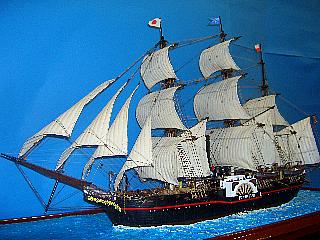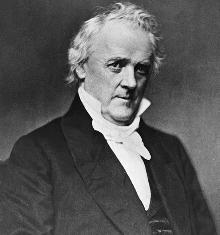|
「萬延元年、小栗上野介ら遣米使節は米国軍艦ポウハタン号で渡米した」と語ると、参詣の方から「咸臨丸では?」という反応がある。ポウハタン号の護衛船だった咸臨丸には初の太平洋横断、というキャッチフレーズがつくが、じつは遣米使節より二百年も前に、田中勝介や支倉常長が日本〜メキシコの往復航海で太平洋横断を果たしている。 When I tell visitors to the temple that in the first year of Man'en, Kozukenosuke
Oguri and other Japanese envoys to the U.S. went to the U.S. aboard the
U.S. warship Powhatan, some of them ask, "Wasn't it the Kanrin Maru
that they boarded?" The Kanrin Maru was only an escort ship for the
Powhatan which the Japanese envoys boarded. Meanwhile, the Kanrin Maru
has a catchphrase "the first Japanese ship to cross the Pacific Ocean,"
but in fact, two hundred years before the U.S.mission, Shousuke Tanaka and
Tsunenaga Hasekura made tras-Pacific crossing from Japan to Mexico and
back respecrively. Settsunokami Yoshitake Kimura, the man in charge of the Kanrin Maru, asked 11 American mariners, including Captain John Mercer Brooke, to join them on the Pacific Ocean crossing aboard the Kanrin Maru. The Americans were looking for a return voyage home after their ship broke up while surveying the waters near Yokohama. Soon after leaving the port of Japan, the Kamrin Maru was caught in a terrible
storm, and most Japanese on board were unable to work due to seasickness,
so most of the ship's operations were performed by the Americans. One of
the few Japanese who could work was John Manjiro. |
|
|---|---|
 ポウハタン号・帆船模型・東善寺蔵 Sailing ship model of the Powhatan, Collection of Tozenji Temple |
|
| 勝海舟や木村は「船酔いのため航海中寝たきり」とブルックの日記や米紙に残る。帰国後、勝や福沢諭吉は「外国人の手は少しも借りないで横断した」と、世話になったブルックらのことはいっさい語らない。「帰国を希望していた米人を乗せてやった」と書く歴史書もある。これらが明治以後の教科書でそのまま採用され、国威発揚気分をくすぐって、いい気になったまま「初の太平洋横断を果たした勝海舟の咸臨丸」神話が定着した。 たとえば数年前、某社の百科全書のゲラにブキャナン大統領の説明で「遣米使節勝海舟が咸臨丸で渡米して会った大統領…」とあるので直すように、と連絡すると礼状が来た。さて発行されると「遣米使節船、咸臨丸が渡米した時の大統領…」という記述になっていた。この大統領に直接会った本当の遣米使節をそっちのけ、まだ咸臨丸神話から抜け出せない。 Katsu Kaishu and Settsunokami Kimura were "bedridden during the voyage due to seasickness," according to Captain Brooke's diary and U.S. newspapers. After returning to Japan, Katsu and Yukichi Fukuzawa wrote, "We crossed the Pacific Ocean without any help from foreigners," and did not mention Brooke and other Americans who helped them. Some history books even say, "They gave lifts to Americans who wanted to return to the U.S. These were adopted in textbooks after the Meiji period, and the myth of "Kaisyu Katsu's Kanrin Maru, which made the first Japanese crossing of the Pacific Ocean" took root, tickling the mood of national prestige and making people feel good about themselves. For example, several years ago, an encyclopedia published by a publishing company included a description of President Buchanan as "the president that Kaishu Katsu, an envoy to the U.S., met when he visited the U.S. on the Kanrin Maru...." When I asked them to correct it, as it was not true, I received a thank-you letter. However, when the encyclopedia was published, it stated," (President Buchanan) was the president when the Japanese envoy to the U.S. went to the U.S. on the Kanrin Maru.... The publisher ignored the real envoys who met the president, which showed that the publisher was still unable to escape the myth of Kanrin Maru. |
|
 |
ブキャナン大統領 第15代大統領 (1857〜1861) President James Buchanan The 15th President of the U.S.A. (1857~1861) |
| バブル景気のころ「日本は経済大国」といばっていた。土地の値上がりは「国力があがった証拠」、「日本式経済は世界の模範」「外国経済から学ぶものはなにもない」という話をたびたび聞かされた。そのころ、寺の外トイレを改築するに際し調べると、遣米使節はやはりワシントンで水洗トイレを使っていた。従者の日記にあった絵をパネルにしてトイレに貼りながら、日本はやっと水洗が普及し始めたのに、「経済大国」とはいい気になりすぎではないか、と不安になった。案の定浮かれ経済は失速し「バブル景気」だったと命名された。 During the bubble economy, people in Japan were touting Japan as an economic superpower. I often heard that "rising land prices are proof of rising national power," "the Japanese-style economy is a model for the rest of the world," and "there is nothing to learn from foreign economies." Around that time, the outside toilet of the temple was to be reconstructed, and I realized that the Japanese envoys to the U.S. had also used flush toilets in Washington, D.C. in 1860. As I pasted a panel of pictures from the diary of a follower of the Japanese envoys to the U.S. on the wall of the toilet, I worried that Japan might be too proud to be called an "economic superpower" when flush systems had barely begun to spread in the country. Sure enough, the buoyant economy stalled and was named the "bubble economy." 近年上野介が注目されるのは、バブル経済がはじけたから。外国の圧力をどうかわして日本の針路を決めるか、アメリカ頼みでよかった時代が終って、気付いたのは幕末によく似ているということ。明治以後よりも幕末の方がよほどたいへんだった、その幕末をほとんど一人で切り回して次の時代へ受け渡した小栗上野介に注目しているのである。浮かれ経済にいい気になっていたときの「埋蔵金の小栗上野介」が、いま「経済人・政治家の小栗上野介」となり、ようやく落ち着いて歴史を見る時代がきたことを感じている。 Kozukenosuke Oguri has been the focus of much attention in recent years, probably because of the bursting of the bubble economy. We are now faced with the question of how to fend off foreign pressure and determine Japan's course... In other words, now that the era of relying on the U.S. is over, we are reminded that the situation is much like the end of the Tokugawa Shogunate. The end of the Edo period was much more difficult than the period after the Meiji era and we are paying attention to Kozukenosuke Oguri, who almost single-handedly managed the end of the Tokugawa Shogunate and passed it on to the next generation. The "Kozukenosuke Oguri of buried treasure" was much talked about when the economy was booming, but now we are seeing Kozukenosuke Oguri as an economist and politician, and I feel that the time has finally come to look at history in a more relaxed manner. ここに小栗上野介の言葉を紹介しよう。 「父親の病気が治る見こみがないからといって、薬を与えないのは孝行ではない。国が滅びても、自分の身が倒れるまで公事に尽くすことが真の武士である」 (2000平成12年) Here are some words that Kozukenosuke Oguri left: "It is not filial piety not to give medicine to a father just because there is no hope of his illness being cured. A true samurai is a man who serves the public even if his country is destroyed, until his own body is destroyed." December 2000, Heisei 12 |
|